Oakland, California Blood Testing Facilities
 Represents a LabCorp blood testing facility
Represents a LabCorp blood testing facility Represents a Quest Diagnostics blood testing facility
Represents a Quest Diagnostics blood testing facility

Nearby Labcorp Blood Testing facilities:
- Labcorp Center Distance: 1 m, 3300 Webster St Suite 107, Oakland, Alameda County, CA, 94609
- Labcorp Center Distance: 3 m, 2850 Telegraph Ave Ste 212, Berkeley, Alameda County, CA, 94705
- Labcorp Center Distance: 6 m, 140 Brookwood Rd. Suite 100, Orinda, Contra Costa County, CA, 94563
- Labcorp Center Distance: 7 m, 728 Pacific Ave. Suite 401, San Francisco, San Francisco County, CA, 94133
- Labcorp Center Distance: 8 m, 2000 Van Ness Ave Ste 215, San Francisco, San Francisco County, CA, 94109
- Labcorp Center Distance: 9 m, 2300 Sutter St Ste 102, San Francisco, San Francisco County, CA, 94115
- Labcorp Center Distance: 10 m, 3466 Mt. Diablo Blvd.Ste C-102, Lafayette, Contra Costa County, CA, 94549
- Labcorp Center Distance: 11 m, 1220 Rossmoor Parkway, Walnut Creek, Contra Costa County, CA, 94598
- Labcorp Center Distance: 12 m, 2622 Ocean Ave., San Francisco, San Francisco County, CA, 94132
- Labcorp Center Distance: 13 m, 2160 Appian Way Ste 205, Pinole, Contra Costa County, CA, 94564
- Labcorp Center Distance: 14 m, 1601 Ygnacio Valley Road, Walnut Creek, Contra Costa County, CA, 94598
- Labcorp Center Distance: 15 m, 500 Lennon Lane, Walnut Creek, Contra Costa County, CA, 94598
- Labcorp Center Distance: 16 m, 2305 Camino Ramon Ste 110, San Ramon, Contra Costa County, CA, 94583
- Labcorp Center Distance: 17 m, 1321 S. Elisio Drive, Greenbrae, Marin County, CA, 94904
- Labcorp Center Distance: 18 m, 150 Glen Cove Marina Rd. 105, Vallejo, Solano County, CA, 94591
- Labcorp Center Distance: 19 m, 4165 Blackhawk Plz Circle 165, Danville, Contra Costa County, CA, 94506
- Labcorp Center Distance: 21 m, 1048 El Camino Real Suite B, Redwood City, San Mateo County, CA, 94063
- Labcorp Center Distance: 22 m, 4125 Mohr Ave. Suite Am, Pleasanton, Alameda County, CA, 94566
- Labcorp Center Distance: 25 m, 853 Middlefield Rd Ste 6, Palo Alto, Santa Clara County, CA, 94301
- Labcorp Center Distance: 27 m, 1018-A Murrieta Blvd., Livermore, Alameda County, CA, 94550
- Labcorp Center Distance: 28 m, 4045 Lone Tree Way Ste B, Antioch, Contra Costa County, CA, 94531
- Labcorp Center Distance: 30 m, 2400 Balfour Rd. Suite 100, Brentwood, Contra Costa County, CA, 94513
- Labcorp Center Distance: 31 m, 2500 Hospital Dr Bldg 11, Mountain View, Santa Clara County, CA, 94040
- Labcorp Center Distance: 32 m, 901 W. El Camino Real, Sunnyvale, Santa Clara County, CA, 94087
- Labcorp Center Distance: 36 m, 3448 Villa Lane Suite 103, Napa, Napa County, CA, 94558
- Labcorp Center Distance: 37 m, 153 Lynch Creek Way, Petaluma, Sonoma County, CA, 94954
- Labcorp Center Distance: 39 m, 50 E. Hamilton Ave. Suite 80, Campbell, Santa Clara County, CA, 95008
- Labcorp Center Distance: 40 m, 777 Knowles Dr Ste 4, Los Gatos, Santa Clara County, CA, 95032
- Labcorp Center Distance: 41 m, 2505 Samaritan Dr Ste 105, San Jose, Santa Clara County, CA, 95124
- Labcorp Center Distance: 42 m, 2060 Aborn Rd Ste 200, San Jose, Santa Clara County, CA, 95121
- Labcorp Center Distance: 44 m, 1370 Medical Center Dr Ste B, Rohnert Park, Sonoma County, CA, 94928
- Labcorp Center Distance: 45 m, 6489 Camden Ave Ste 107, San Jose, Santa Clara County, CA, 95120
- Labcorp Center Distance: 49 m, 4769 Hoen Avenue, Santa Rosa, Sonoma County, CA, 95405
- Labcorp Center Distance: 50 m, 1111 Sonoma Ave Ste 121, Santa Rosa, Sonoma County, CA, 95405
- Labcorp Center Distance: 52 m, 3540 Mendocino Ave Ste 400, Santa Rosa, Sonoma County, CA, 95403
- Labcorp Center Distance: 54 m, 1617 N. California Street, Stockton, San Joaquin County, CA, 95204
- Labcorp Center Distance: 58 m, 8465 Old Redwood Hwy Ste 400, Windsor, Sonoma County, CA, 95492
- Labcorp Center Distance: 65 m, 272 Green Valley Road, Freedom, Santa Cruz County, CA, 95019
- Labcorp Center Distance: 66 m, 700 W. 6Th St. Ste E, Gilroy, Santa Clara County, CA, 95020
- Labcorp Center Distance: 69 m, 1541 Florida Ave. Suite 102, Modesto, Stanislaus County, CA, 95350
- Labcorp Center Distance: 70 m, 1524 Mchenry Ave. Suite 160, Modesto, Stanislaus County, CA, 95350
- Labcorp Center Distance: 79 m, 6620 Coyle Ave Ste 109, Carmichael, Sacramento County, CA, 95608
- Labcorp Center Distance: 80 m, 1801 Colorado Ave. Suite 200, Turlock, Stanislaus County, CA, 95382
- Labcorp Center Distance: 83 m, 1326 Natividad Rd. Suite A, Salinas, Monterey County, CA, 93906
- Labcorp Center Distance: 84 m, 1008 Riley St Ste 4, Folsom, Sacramento County, CA, 95630
- Labcorp Center Distance: 85 m, 1600 Creekside Dr Ste 3500, Folsom, Sacramento County, CA, 95630
- Labcorp Center Distance: 86 m, 6815 Five Star Blvd Suite 105, Rocklin, Placer County, CA, 95677
- Labcorp Center Distance: 91 m, 89 Lincoln Blvd., Lincoln, Placer County, CA, 95648
- Labcorp Center Distance: 92 m, 222 I Street, Los Banos, Merced County, CA, 93635
Nearby Quest Blood Testing facilities:
- Quest Center Distance: 1 m, 3300 Webster St, Oakland, Alameda County, CA, 94609-3106
- Quest Center Distance: 2 m, 2111 Whitehall Place, Alameda, Alameda County, CA, 94501-6160
- Quest Center Distance: 5 m, 7200 Bancroft Ave, Oakland, Alameda County, CA, 94605-2468
- Quest Center Distance: 9 m, 2198 15Th St, San Francisco, San Francisco County, CA, 94114-1213
- Quest Center Distance: 12 m, 20400 Lake Chabot Rd, Castro Valley, Alameda County, CA, 94546-5314
- Quest Center Distance: 14 m, 901 Campus Dr, Daly City, San Mateo County, CA, 94015-4930
- Quest Center Distance: 15 m, 120 S El Camino Real, Millbrae, San Mateo County, CA, 94030-3133
- Quest Center Distance: 16 m, 1241 East Hillsdale Blvd, Foster City, San Mateo County, CA, 94404-0000
- Quest Center Distance: 17 m, 1000 S Eliseo Dr, Greenbrae, Marin County, CA, 94904-2133
- Quest Center Distance: 19 m, 2042 Columbus Pkwy, Benicia, Solano County, CA, 94510-5400
- Quest Center Distance: 20 m, 1100 Laurel Street, San Carlos, San Mateo County, CA, 94070-5000
- Quest Center Distance: 22 m, 556 Mowry Avenue, Fremont, Alameda County, CA, 94536-4186
- Quest Center Distance: 27 m, 1090 E Stanley Blvd, Livermore, Alameda County, CA, 94550-4157
- Quest Center Distance: 31 m, 205 South Dr, Mountain View, Santa Clara County, CA, 94040-4323
- Quest Center Distance: 32 m, 649 E Calaveras Blvd, Milpitas, Santa Clara County, CA, 95035-7708
- Quest Center Distance: 33 m, 1411 Oliver Road, Fairfield, Solano County, CA, 94534-3424
- Quest Center Distance: 36 m, 3260 Beard Road, Napa, Napa County, CA, 94558-3406
- Quest Center Distance: 37 m, 1550 Professional Drive, Petaluma, Sonoma County, CA, 94954-6655
- Quest Center Distance: 38 m, 2618 Alum Rock Ave, San Jose, Santa Clara County, CA, 95116-2621
- Quest Center Distance: 39 m, 840 Willow St, San Jose, Santa Clara County, CA, 95125-2384
- Quest Center Distance: 41 m, 770 Mason St, Vacaville, Solano County, CA, 95688-4648
- Quest Center Distance: 45 m, 632 West 11Th Street, Tracy, San Joaquin County, CA, 95376-3856
- Quest Center Distance: 50 m, 990 Sonoma Ave, Santa Rosa, Sonoma County, CA, 95404-4813
- Quest Center Distance: 52 m, 1708 W Hammer Ln, Stockton, San Joaquin County, CA, 95209-2922
- Quest Center Distance: 54 m, 510 E. Magnolia Street, Stockton, San Joaquin County, CA, 95202-1850
- Quest Center Distance: 55 m, 1801 E March Ln, Stockton, San Joaquin County, CA, 95210-6660
- Quest Center Distance: 57 m, 50 East Main Avenue, Morgan Hill, Santa Clara County, CA, 95037-3661
- Quest Center Distance: 58 m, 1595 Soquel Drive, Santa Cruz, Santa Cruz County, CA, 95065-1720
- Quest Center Distance: 62 m, 7248 South Land Park Drive, Sacramento, Sacramento County, CA, 95831-3661
- Quest Center Distance: 64 m, 8191 Timberlake Way, Sacramento, Sacramento County, CA, 95823-5418
- Quest Center Distance: 65 m, 1045 Sperry Ave, Patterson, Stanislaus County, CA, 95363-9286
- Quest Center Distance: 66 m, 1837 E Gibson Rd, Woodland, Yolo County, CA, 95776-5168
- Quest Center Distance: 70 m, 1524 Mchenry Ave, Modesto, Stanislaus County, CA, 95350-4566
- Quest Center Distance: 73 m, 2531 E Whitmore Ave, Ceres, Stanislaus County, CA, 95307-2646
- Quest Center Distance: 76 m, 7423 Fair Oaks Blvd, Carmichael, Sacramento County, CA, 95608-1797
- Quest Center Distance: 80 m, 777 E Hawkeye Ave, Turlock, Stanislaus County, CA, 95380-7507
- Quest Center Distance: 83 m, 631 E Alvin Dr, Salinas, Monterey County, CA, 93906-3056
- Quest Center Distance: 85 m, 1600 Creekside Drive, Folsom, Sacramento County, CA, 95630-3445
- Quest Center Distance: 89 m, 223 Clinton Rd, Jackson, Amador County, CA, 95642-2603
- Quest Center Distance: 92 m, 730 W I St, Los Banos, Merced County, CA, 93635-3421
- Quest Center Distance: 97 m, 1025 Bridge St, Colusa, Colusa County, CA, 95932-2870
Oakland California Hormone Replacement Therapy Services
Hormone Optimization is the rising star of Wellness Science. It turns out that healthy Hormone Levels are a crucial aspect of maintaining vitality as we enter the Golden Years. Hormone Imbalance has a devastating and life-altering impact on the human body's ability to keep up with the demands of everyday life. Each day, millions of men and women across the nation struggle with Hormonal Issues, and the majority don't even realize it.
At our Oakland Hormone Clinic, we specialize in the diagnosis and treatment of a whole range of Hormone-Related Medical Issues, most notably HGH Deficiency and Low-T. Hormone Imbalance is a common medical issue, and nothing to be ashamed about. Let our Licensed and Fully Certified HRT Specialists work with you to determine your candidacy for Recombinant Hormone Therapy!
HGH Injections in Oakland California
Human Growth Hormone is a powerful mediator of physiological function. HGH is responsible for releasing and unlocking the energy stored in our fat cells, and it is also responsible for facilitating rejuvenation and rehabilitation at the cellular level. HGH Deficiency is difficult to pinpoint and requires a blood test, but its symptoms are highly recognizable.
Age-Related Human Growth Hormone Deficiency, or Somatopause, is characterized by a host of symptoms related to impaired cellular metabolism, such as joint pain, increased prevalence and severity of illness, depression, diminished muscle mass, increased body fat, cognitive fogginess and lack of focus, fatigue, and more. If these symptoms have been plaguing your life, and you feel that HGH Therapy may be able to help you enhance your wellness, our Hormone Doctors and Endocrinologists can assess your eligibility for HGH Restoration!
Oakland Sermorelin Therapy Alternative to Growth Hormone
When it comes to Somatopause Relief, there are two options on the table: Bio-Identical HGH Shots and Sermorelin Acetate Injections. Both have been proven highly effective at relieving the symptoms of Age-Associated Growth Hormone Decline, but work via different biological pathways. Growth Hormone Injections do as you would imagine—they resolve deficiency by directly supplementing your fading supply of natural HGH. Sermorelin works by stimulating the body's production of its own precious Growth Hormone.
While both treatments provide fantastic results for aging men and women struggling with Somatopause, Sermorelin has discovered increasing popularity since the turn of the century, because it has similar effectiveness as compared to HGH Injections, but is less expensive and is available to a wider range of patients. Our HRT Specialists offer Free Consultation and can help you understand the nuanced differences between these two quality Hormone Treatments!
Oakland Low-T Clinics for Testosterone Deficiency
Though we place great pride in our extensive training in the treatment and maintenance of HGH Deficiency, we also offer many other HRT Treatments which may appeal to you. Low-T can be one of the most exasperating and infuriating forms of Hormone Imbalance that a man can experience. As Testosterone Levels decline, so do sexual desire and function. Testosterone Deficiency has ruined countless relationships over the course of the last forty years, but it doesn't have to be that way.
Research continues to show that Low-T is effectively treated with Bio-Identical Hormone Therapy. Thousands of men across the San Francisco Bay Area have successfully found relief through the use of Recombinant Testosterone Creams, Patches, and Low-T Injections. Could you be the next? Don't let fatigue, diminished exercise capacity, anxiety, and sexual insufficiency get you down. See if you're a candidate for Bio-Identical Testosterone today!
Oakland Comprehensive Hormone Testing with LabCorp and Quest Diagnostics
The key to accurate HRT Diagnosis and Safe Hormone Replacement Therapy is to be fully evaluated via bloodwork. The only way to truly reveal your underlying need for Hormone Optimization is with a thoroughly evaluated blood sample. Our Oakland HRT Clinic works with award-winning Lab Testing Facilities Quest Diagnostics and LabCorp to provide you with rapid and accurate Hormone Deficiency Testing.
Our affiliate medical partners have Testing Centers located all over the state of California and can meet with you in just a matter of days. In many cases, they can even come directly to you! With just a quick, no-nonsense physical and a single prick, we can quickly and accurately assess your Hormone Therapy Needs!
Information and Quick Facts About Oakland
Oakland is one of the major cities which comprise the famous Bay Area of California. Though San Francisco is the most well-known city in the region, Oaktown, as it is popularly referred to, is vital both as a center of culture and economy. Though Oakland has a complex history, the 21st century has seen a rapid advance in opportunity and quality of life across most of the city. The heart of the Oakland economy is its port system. Oakland has one of the busiest ports in the entire United States, transferring hundreds of millions of pounds of cargo annually.
Oakland also has a burgeoning tech scene, owing to its proximity to San Francisco and the Silicon Valley. Among the many companies that HQ out of Oakland California are Pandora Radio, Clorox, Cost Plus, and Kaiser Permanente. Other employers of note in the city are Southwest Airlines, UPS, and Alameda Health System. Among the many things that Oakland is known for, its music scene is considered one of the best in the United States. It's ethnic diversity and its long African Heritage have led the area to be the home to countless influential musical acts, such as The Pointer Sisters, En Vogue, Hieroglyphics, Keyshia Cole, and Machine Head.
All About Oakland, California Geographic Area
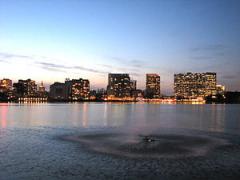
Oakland ( /ËnoÊoklÉond/), located in the U.S. state of California, is a major West Coast port city and the busiest port for San Francisco Bay and all of Northern California. It is the third largest city in the San Francisco Bay Area, the eighth-largest city in the state, and the 47th-largest city in the U.S. with a population of 395,817. Incorporated in 1852, Oakland is the county seat of Alameda County. It serves as a major transportation hub and trade center for the entire region and is also the principal city of the Bay Area Region known as the East Bay. The city is situated directly across the bay six miles east from San Francisco.
/ËnoÊoklÉond/), located in the U.S. state of California, is a major West Coast port city and the busiest port for San Francisco Bay and all of Northern California. It is the third largest city in the San Francisco Bay Area, the eighth-largest city in the state, and the 47th-largest city in the U.S. with a population of 395,817. Incorporated in 1852, Oakland is the county seat of Alameda County. It serves as a major transportation hub and trade center for the entire region and is also the principal city of the Bay Area Region known as the East Bay. The city is situated directly across the bay six miles east from San Francisco.
Oakland's territory covers what was once a mosaic of coastal terrace prairie, oak woodland, and north coastal scrub. Its land served as a rich resource when its hillside oak and redwood timber were logged to build San Francisco, and Oakland's fertile flatland soils helped it become a prolific agricultural region. In the late 1860s, Oakland was selected as the western terminal of the Transcontinental Railroad. It continued to grow into the 20th century with its busy port, shipyards, and a thriving automobile industry. Following the 1906 San Francisco earthquake, many San Franciscans relocated to Oakland, increasing the city's population, housing and infrastructure.
A steady influx of immigrants during the 20th century, along with thousands of African-American war-industry workers who relocated from the Deep South during the 1940s, have made Oakland one of the most ethnically diverse major cities in the country. Oakland is known for its history of political activism, as well as its professional sports franchises and major corporations, which include health care, dot-com companies and manufacturers of household products. The city is a transportation hub for the greater Bay Area, and its shipping port is the fifth busiest in the United States.
Oakland has a Mediterranean climate with an average of 260 sunny days per year. Lake Merritt, a large estuary centrally located east of Downtown, was designated the United States' first official wildlife refuge. Jack London Square, named for the author and former resident, is a tourist destination on the Oakland waterfront. Little progress has been made in reducing the city's high crime rate; violent crime is primarily concentrated in certain neighborhoods, although property crime remains problematic throughout the city. Oakland is continually listed among the top cities in the United States for sustainability practices, including a No. 1 ranking for usage of electricity from renewable resources.
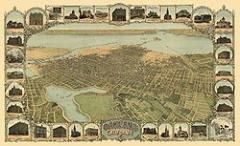
The earliest known inhabitants were the Huchiun tribe, who lived there for thousands of years. The Huchiun belonged to a linguistic grouping later called the Ohlone (a Miwok word meaning "western people"). In Oakland, they were concentrated around Lake Merritt and Temescal Creek, a stream that enters the San Francisco Bay at Emeryville.
Conquistadors from New Spain claimed Oakland and other Ohlone lands of the East Bay, along with the rest of California, for the king of Spain in 1772. In the early 19th century, the Spanish crown deeded the East Bay area to LuRs MarRa Peralta for his Rancho San Antonio. The grant was confirmed by the successor Mexican republic upon its independence from Spain. The ranch included a stand of oak trees that stretched from the land that is today Oakland's downtown area to the adjacent part of Alameda, then a peninsula. The Peraltas called the area encinal, a Spanish word that means "oak grove." Upon his death in 1842, Peralta divided his land among his four sons. Most of Oakland fell within the shares given to Antonio Maria and Vicente, who opened the land to American settlers, loggers, European whalers, and fur-traders
Continued development occurred after 1848 when, as part of the Treaty of Guadalupe Hidalgo following the Mexican-American War, the Mexican government ceded 525,000 square miles (1,360,000 km2); 55% of its pre-war territory (excluding Texas) to the US in exchange for $15 million. The original settlement in what is now the downtown was initially called "Contra Costa" ("opposite shore", the Spanish name for the lands on the east side of the Bay) and was included in Contra Costa County before Alameda County was established on March 25, 1853. The California state legislature incorporated the town of Oakland on May 4, 1852. In 1853, John Coffee "Jack" Hays, a famous Texas Ranger, was one of the first to establish residence in Oakland while performing his duties as Sheriff of San Francisco.
The town and its environs quickly grew with the railroads, becoming a major rail terminal in the late 1860s and 1870s. In 1868, the Central Pacific constructed the Oakland Long Wharf at Oakland Point, the site of today's Port of Oakland. The Long Wharf served as the terminus both for the Transcontinental Railroad and for local commuter trains of the Central (later, Southern) Pacific. The Central Pacific also established one of its largest rail yards and servicing facilities in West Oakland, which continued to be a major local employer under the Southern Pacific well into the 20th century. The principal depot of the Southern Pacific in Oakland was the 16th Street Station located at 16th and Wood, which is currently being restored as part of a redevelopment project. In 1871, Cyrus and Susan Mills paid $5,000 for the Young Ladies' Seminary in Benicia, renamed it Mills College, and moved it to its current location in Oakland, adjacent to what is now Seminary Boulevard. In 1872, the town of Brooklyn was incorporated into Oakland. Brooklyn, a large municipality southeast of Lake Merritt, was part of what was then called the Brooklyn Township.
A number of horsecar and cable car lines were constructed in Oakland during the latter half of the 19th century. The first electric streetcar set out from Oakland to Berkeley in 1891, and other lines were converted and added over the course of the 1890s. The various streetcar companies operating in Oakland were acquired by Francis "Borax" Smith and consolidated into what eventually became known as the Key System, the predecessor of today's publicly owned AC Transit. In addition to its system of streetcars in the East Bay, the Key System also operated commuter trains to its own pier and ferry boats to San Francisco, in competition with the Southern Pacific. Upon completion of the Bay Bridge, both companies ran their commuter trains on the south side of the lower deck, directly to San Francisco. The Key System in its earliest years was actually in part a real estate venture, with the transit part serving to help open up new tracts for buyers. The Key System's investors (incorporated as the "Realty Syndicate") also established two large hotels in Oakland, one of which survives as the Claremont Resort. The other, which burned down in the early 1930s, was the Key Route Inn, at what is now West Grand and Broadway. From 1904 to 1929, the Realty Syndicate also operated a major amusement park in north Oakland called Idora Park.

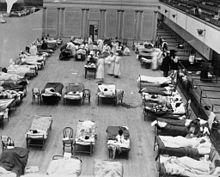
The original extent of Oakland, upon its incorporation, lay south of today's major intersection of San Pablo Avenue, Broadway, and Fourteenth Street. The city gradually annexed farmlands and settlements to the east and the north. Oakland's rise to industrial prominence, and its subsequent need for a seaport, led to the digging of a shipping and tidal channel in 1902, which created an "island" of nearby town Alameda. In 1906, its population doubled with refugees made homeless after the 1906 San Francisco earthquake and fire. Concurrently, a strong City Beautiful movement, promoted by Mayor Frank Kanning Mott, was responsible for creating and preserving parks and monuments in Oakland, including major improvements to Lake Merritt and the construction of Oakland Civic Auditorium, which cost $1M in 1914. The Auditorium briefly served as an emergency ward and quarantine for some of Oakland's Spanish flu victims in 1918 and 1919. The three waves of the pandemic killed more than 1,400, out of 216,000, Oakland residents.
By 1920, Oakland was the home of numerous manufacturing industries, including metals, canneries, bakeries, internal combustion engines, automobiles, and shipbuilding.
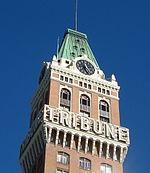
The 1920s were economic boom years in the United States as a whole, and in California in particular. Economic growth was fueled by the general post aeWorld War I recovery, as well as oil discoveries in Los Angeles and, most notably, the widespread introduction of the automobile. In 1916, General Motors opened a major Chevrolet automobile factory in East Oakland, making cars and then trucks until 1963, when it was moved to Fremont in southern Alameda County. Also in 1916, the Fageol Motor Company chose East Oakland for their first factory, manufacturing farming tractors from 1918 to 1923. In 1921, they introduced an influential low-slung "Safety Bus", followed quickly by the 22-seat "Safety Coach." Durant Motors operated a plant in Oakland from 1921 to 1930, manufacturing sedans, coupes, convertibles, and roadsters. By 1929, when Chrysler expanded with a new plant there, Oakland had become known as the "Detroit of the West."
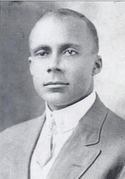
Oakland expanded during the 1920s, flexing enough to meet the influx of factory workers. Approximately 13,000 homes were built between 1921 and 1924, more than between 1907 and 1920. Many of the large downtown office buildings, apartment buildings, and single-family houses still standing in Oakland were built during the 1920s; and they reflect the architectural styles of the time.
In 1926 Dr. William M. Watts (pictured left) opened a 22-bed hospital facility to provide in-patient care to Oakland's citizens of African descent who were not welcome at other health care institutions. The facility also offered training for African-American nurses.
The Rocky Road ice cream was created in Oakland in 1929, though accounts differ about its first promoter. William Dreyer of Dreyer's is said to have carried the idea of marshmallow and walnut pieces in a chocolate base over from his partner Joseph Edy's similar candy creation.
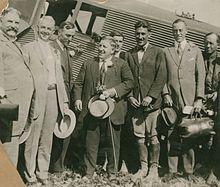
Russell Clifford Durant (called "Cliff" by his friends) was a race car driver, speedboat enthusiast, amateur flier, President of Durant Motors in Oakland, and son of General Motors founder William "Billy" Crapo Durant. In 1916, he established Durant Field at 82nd Avenue and East 14th Street. The first experimental transcontinental airmail through-flight finished its journey at Durant Field on August 9, 1920, with Army Capt. Eddie Rickenbacker and Navy Lt. Bert Acosta (pictured right) at the controls of the Junkers F 13 re-badged as the model J.L.6. The airfield served only secondary duties after 1927, as its runway was not long enough for heavily loaded aircraft. In April 1930, test pilot Herbert "Hub" Fahy and his wife Claire hit a stump upon landing, flipping their plane and mortally wounding Hub without injuring Claire. Durant Field was often called Oakland Airport, though the current Oakland International Airport was soon established four miles (6 km) southwest.
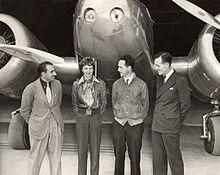
On September 17, 1927, Charles Lindbergh attended the official dedication of the new Oakland Airport. A month earlier, on August 16, participants in the disastrous Dole Air Race had taken off from Oakland's new 7,020-foot (2,140 m) runway headed for Honolulu, Hawaii 2,400 miles (3,900 km) away aethree fliers died before getting to the starting line in Oakland; five were lost at sea, attempting to reach Honolulu; and two more died searching for the lost five.
On May 31, 1928, Charles Kingsford Smith and his crew departed Oakland in Southern Cross on their successful bid to cross the Pacific by air, finishing in Australia. In October 1928, Oakland was used as a base for the World War I aircraft involved in the final filming of Howard Hughes' Hell's Angels. In 1928, aviator Louise Thaden took off from Oakland in a Travel Air to set a women's altitude record, as well as endurance and speed records.
On January 11, 1935, Amelia Earhart became the first person to fly solo from Honolulu, Hawaii to Oakland, California.
On St. Patrick's Day, March 17, 1937, Earhart and her crew, Paul Mantz, Harry Manning and Fred Noonan, flew the first leg of her attempt to circumnavigate the globe, from Oakland to Honolulu, Hawaii. That attempt ended in Hawaii when her Lockheed Electra 10E was severely damaged. Later in the year, Earhart began her second, ill-fated attempt with the unpublicized first leg of her proposed transcontinental flight mapped from Oakland to Miami, Florida.
During World War II, the East Bay Area was home to many war-related industries. Among these were the Kaiser Shipyards in nearby Richmond. The medical system devised for shipyard workers became the basis for the giant Kaiser Permanente HMO, which has a large medical center at MacArthur and Broadway, the first to be established by Kaiser. Oakland's Moore Dry Dock Company expanded its shipbuilding capabilities and built over 100 ships.
Valued at $100 million in 1943, Oakland's canning industry was its second-most-valuable war contribution after shipbuilding. Sited at both a major rail terminus and an important sea port, Oakland was a natural location for food processing plants, whose preserved products fed domestic, foreign, and military consumers. The largest canneries were in the Fruitvale District and included the Josiah Lusk Canning Company, the Oakland Preserving Company (which started the Del Monte brand), and the California Packing Company.
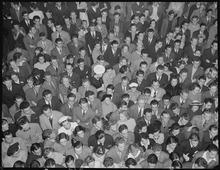
Prior to World War II, blacks constituted about 3% of Oakland's population. Aside from restrictive covenants pertaining to some Oakland Hills properties, Jim Crow laws mandating racial segregation did not exist in California, and relations between the races were mostly harmonious. What segregation did exist was voluntary; blacks could, and did, live in all parts of the city.
The war attracted tens of thousands of laborers from around the country, though most were poor whites and blacks from Alabama, Arkansas, Georgia, Louisiana, Mississippi, Missouri, South Carolina, Tennessee and Texas aesharecroppers and tenant farmers who had been recruited by Henry J. Kaiser to work in his shipyards. These immigrants from the Jim Crow South brought their racial attitudes with them, and the racial harmony that Oakland blacks had been accustomed to prior to the war evaporated. Southern whites expected deference from their black co-workers, and initially Southern blacks were conditioned to grant it. As Southern blacks became aware of their more equal standing under California law, they began to reject subservient roles; the new immigrants prospered, though they were affected by rising racial discrimination and informal post-war neighborhood redlining.
The Mai Tai cocktail was first concocted in Oakland in 1944, and it became very popular at Trader Vic's restaurant. Established in 1932, just four years later, Trader Vic's was so successful San Francisco Chronicle columnist Herb Caen was inspired to write, "the best restaurant in San Francisco is in Oakland." Trader Vic's was chosen by the State Department as the official entertainment center for foreign dignitaries attending United Nations meetings in San Francisco. The restaurant continued to grow in popularity and was running out of room when, in 1951, founder Victor Bergeron opened a larger one in San Francisco. In 1972, the flagship Oakland restaurant moved to the nearby Emeryville Marina.
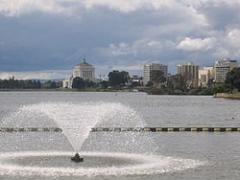
In 1946 National City Lines (NCL), a General Motors holding company, acquired 64% of Key System stock; during the next several years NCL engaged in the conspiratorial dissolution of Oakland's electric streetcar system. NCL converted the Key System's electric streetcar fleet to diesel buses, tracks were removed from Oakland's streets, and the lower deck of the Bay Bridge was converted to automobile traffic, which reduced the passenger carrying capacity of the bridge. Freeways were constructed, which partitioned the social and retail fabric of neighborhoods. In the 1948 federal case "United States v. National City Lines Inc.," the defendants were found guilty on a count of conspiring to monopolize the provision of parts and supplies to their subsidiary companies. The companies were each fined $5,000, and the directors were each fined one dollar. The verdicts were upheld on appeal in 1951. The state Legislature created the Alameda and Contra Costa Transit District in 1955, which still exists today as AC Transit, the third-largest bus-only transit system in the nation.
Soon after the war, with the disappearance of Oakland's shipbuilding industry and the decline of its automobile industry, jobs became scarce. Many of the poor blacks who had come to the city from the South decided to stay in Oakland, and longstanding black residents complained that the new Southern arrivals "tended towards public disorder." The segregationist attitudes that some Southern migrants brought with them disrupted the racial harmony that Oaklanders had been accustomed to before the war. Many of the city's more affluent residents, both black and white, left the city after the war, moving to neighboring Alameda, Berkeley, Albany and El Cerrito to the north; to San Leandro, Hayward, Castro Valley and Fremont in Southern Alameda County; and to the newly developing East Bay suburbs, Orinda, Lafayette, Pleasant Hill, Walnut Creek and Concord. Between 1950 and 1960, about 100,000 white property owners moved out of Oakland aepart of a nationwide phenomenon called white flight.
By the end of World War II, blacks constituted about 12% of Oakland's population, and the years following the war saw this percentage rise. There was also an increase in racial tension. Starting in the late 1940s, the Oakland Police Department began recruiting officers from the South to deal with the expanding black population and changing racial attitudes; many were openly racist, and their repressive police tactics exacerbated racial tensions.
Oakland was the center of a general strike during the first week of December 1946, one of six cities across the country that experienced such a strike after World War II. It was one of the largest strike movements in American history, as workers were determined not to let management repeat the union busting that followed the first World War. Oakland, which had been racially harmonious and prosperous before the war, by the late 1950s found itself with a population that was becoming progressively more poor and racially divided.
In 1960, Kaiser Corporation erected its headquarters at the former site of Holy Names University, at the corner of 20th and Harrison Streets. It was the largest skyscraper in Oakland, as well as "the largest office tower west of Chicago" up to that time. During this era, the oldest section of Oakland at the foot of Broadway, Jack London Square, was redeveloped into a hotel and outdoor retail district. During the 1960s, the city was home to an innovative funk music scene that produced well-known bands like Sly & the Family Stone, Graham Central Station, Tower of Power, Cold Blood, and The Headhunters. Larry Graham, the bass player for both Sly & the Family Stone and Graham Central Station, is credited with the creation of the influential slap and pop sound still widely used by bassists in many musical idioms today.
By 1966, only 16 of the city's 661 police officers were black. Tensions between the black community and the largely white police force were high, and police malfeasance against blacks was common. The Black Panther Party was founded by Oakland City College (later Merritt College) students Huey Newton and Bobby Seale .
It was also during the 1960s that the Oakland chapter of the Hells Angels Motorcycle Club began to grow into a formidable motorcycle gang and organized crime syndicate. The Hells Angels clubhouse is still located on Oakland's Foothill Boulevard.
During the 1970s, Oakland began to experience serious problems with gang-controlled dealing of heroin and cocaine when drug kingpin Felix Mitchell created the nation's first large-scale operation of this kind. Both violent crime and property crime increased during this period, and Oakland's murder rate rose to twice that of San Francisco or New York City.
In late 1973, the Symbionese Liberation Army assassinated Oakland's superintendent of schools, Dr. Marcus Foster, and badly wounded his deputy, Robert Blackburn. Two months later, two men were arrested and charged with the murder. Both received life sentences, though one was acquitted after an appeal and a retrial seven years later.
In sports, the Oakland Athletics MLB club won three consecutive World Series championships in 1972, 1973, and 1974, in addition to three consecutive World Series appearances from 1988 to 1990; the A's won the 1989 contest. The Golden State Warriors won the 1974 ae1975 NBA championship. The Oakland Raiders of the NFL won Super Bowl XI in 1977, Super Bowl XV in 1981, and after the 1983 season (their second season since the temporary LA move), they defeated the Washington Redskins in Super Bowl XVIII to capture a third championship, while also appearing in Super Bowl II in 1968 and Super Bowl XXXVII in 2003.
Starting in the early 1980s, the number of Latinos, mostly of Mexican origin, began to increase in Oakland, especially in the Fruitvale district. This district is one of the oldest in Oakland, growing up around the old Peralta estate (now a city park). It always had a concentration of Latino residents, businesses and institutions, and increased immigration, continuing into the 21st century, has added greater numbers.
As in many other American cities during the 1980s, crack cocaine became a serious problem in Oakland. Drug dealing in general, and the dealing of crack cocaine in particular, resulted in elevated rates of violent crime, causing Oakland to consistently be listed as one of America's most crime-ridden cities.
During the late 1980s and early 1990s, Oakland's black plurality reached its peak at approximately 47% of the overall population. Oakland was the birthplace or home at one time of several rap acts, including MC Hammer, Digital Underground, Hieroglyphics (including Souls of Mischief and Del tha Funkee Homosapien), The Luniz, Tupac Shakur, and Too Short. Outside of the rap genre, artists such as the Pointer Sisters, En Vogue, Tony! Toni! Tone!, and Billie Joe Armstrong of Green Day also emerged from Oakland.
On May 24, 1990, a pipe bomb placed underneath traveling eco-activist Judi Bari's car seat exploded, tearing through her backside and nearly killing her. The bomb was placed directly under the driver's seat, not in the back seat or luggage area as it presumably would have been if Bari had been transporting it knowingly. Immediately after the 1990 car bombing, while Bari was in Oakland's Highland Hospital, she and a friend were arrested on suspicion of knowingly transporting the bomb. The Alameda County district attorney later dropped the case for lack of evidence, and in 2004 the FBI and the City of Oakland agreed to a $4 million settlement of a lawsuit brought by Bari's estate, and her friend, over their false arrest.
On October 20, 1991, a massive firestorm (see 1991 Oakland firestorm) swept down from the Berkeley Hills above the Caldecott Tunnel. Twenty-five people were killed, and 150 people were injured, with nearly 4,000 homes destroyed. The economic losses have been estimated at $1.5 billion. The economic losses, in combination with injuries and loss of life, make this the worst urban firestorm in American history. Many of the original homes were rebuilt on a much larger scale.
In late 1996, Oakland was the center of a controversy surrounding Ebonics (African American Vernacular English), an ethnolect the outgoing Oakland Unified School District board voted to recognize on December 18. This was later dropped.
During the mid 1990s, Oakland experienced an improved economy compared to previous decades, with new downtown land development such as a $140 million state government center project, a $101 million city office building, and a 12-story office building for the University of California, Office of the President. The City Center redevelopment project was bought by Shorenstein Co., a San Francisco real estate firm. Office vacancies dropped to 11 percent from 16 percent in 1996. Officials at the Port of Oakland and Oakland International Airport, began multimillion-dollar expansion plans to keep pace with rival shipping ports and airports on the West Coast.
The Loma Prieta earthquake occurred on October 17, 1989, a rupture of the San Andreas fault that affected the entire San Francisco Bay Area. The quake's surface wave measured 7.1 on the Richter magnitude scale, and many structures in Oakland were badly damaged. The double-decker portion of the freeway (Interstate 880) structure collapsed. The eastern span of the San Francisco ae Oakland Bay Bridge also sustained damage and was closed to traffic for one month.
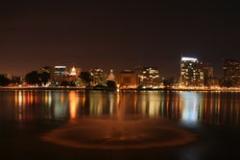
After his 1999 inauguration, Oakland Mayor Jerry Brown continued his predecessor Elihu Harris' public policy of supporting downtown housing development in the area defined as the Central Business District in Oakland's 1998 General Plan. Since Brown's stated goal was to add 10,000 residents to downtown Oakland, it became known as the "10K" plan. It resulted in redevelopment projects in the Jack London District, where Brown purchased and later sold an industrial warehouse, which he used as a personal residence, and in the Lakeside Apartments District near Lake Merritt, where two infill projects were approved. The 10K plan touched the historic Old Oakland district, the Chinatown district, the Uptown district, and downtown.
The 10K plan and other redevelopment projects were controversial due to potential rent increases and gentrification, which would displace lower-income residents from downtown Oakland into outlying neighborhoods and cities. Additional controversy over development proposals arose from the weakening of the Bay Area and national economy in 2000, 2001, 2007, and the credit crunch and the recession of 2008. These downturns resulted in lowered sales, rentals and occupancy of the new housing and slower growth and economic recovery than expected.
The Oakland Athletics have long sought a site to build a new baseball stadium. A deal announced in 2006 to build a new park in Fremont, to be called Cisco Field was halted three years later as a result of opposition from businesses and local residents. Local efforts have been put forth by both fans and city politicians to retain the A's, including three potential locations near downtown and the Oakland waterfront. The South Bay city of San Jose has shown continuing, strong interest to be the team's new home, and is the preferred destination for current team owner Lew Wolff.
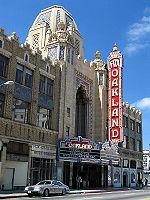
The Oakland Ballet, performing in the city since 1965, folded temporarily in 2006 due financial problems and the closure of their performance facility, the Calvin Simmons Theater at the Kaiser Convention Center. The following year, founder Ronn Guidi announced the revival of the Ballet under new director Graham Lustig, and the program continues to perform at the Laney College Theater.
In the early morning hours of January 1, 2009, unarmed civilian Oscar Grant was shot and killed by BART police officer Johannes Mehserle on a crowded platform at the Fruitvale BART Station in East Oakland. Officers had subdued Grant in a prone position for allegedly resisting arrest, before Mehserle shot Grant in the back with his gun, which he claimed to have mistaken for his stun gun. In the ensuing week, demonstrations and riots took place in Downtown Oakland, with demonstrators citing police brutality and racial injustice as their motivation. Mehserle was convicted of involuntary manslaughter in July 2010, and sentenced to two years in prison. Both the verdict and sentencing set off further demonstrations in downtown Oakland, which included looting and destruction of property.
In February 2009, the Fox Oakland Theatre reopened. The theatre had been closed for most of the previous 42 years, with few events held there. After a thorough restoration, seismic retrofit, and many other improvements following years of severe neglect (including a fire as recently as 2004), the historic landmark theater started drawing patrons from all over the Bay Area.
On March 21, 2009, Oakland parolee Lovelle Mixon, 26, fatally shot four Oakland police officers, and wounded a fifth officer. At approximately 1 pm, Mixon shot and killed two officers during a routine traffic stop. Mixon fled the scene, hiding in his sister's nearby apartment, and shortly after 3 pm he killed two more officers. During the ensuing shootout, the police killed Mixon in self-defense and a fifth officer was wounded. Three of the officers killed were ranking sergeants, the first time the Oakland Police Department had lost a sergeant in the line of duty. It was the single deadliest day for sworn personnel in the department's history.
Due to alleged misconduct by the Oakland Police Department, the City of Oakland has paid a total of $57 million during the 2001-2011 timeframe to alleged victims of police abuse aethe largest sum of any city in California.
On October 10, 2011, protesters and civic activists began "Occupy Oakland" demonstrations directed against national social and economic inequality at Frank Ogawa Plaza in Downtown Oakland. The demonstrators set up an encampment which at one point consisted of "a miniature city" with as many as 150 tents. At one point, a second encampment was established at Snow Park on Lake Merritt. Oakland Police raided and dismantled the two protest sites at Frank Ogawa Plaza and Snow Park early in the morning on October 25. Later the same day, in efforts to reestablish the encampments, protesters clashed with police. Two officers and three protesters were injured and more than a hundred people were arrested. On November 2, thousands marched upon and shut down the Port of Oakland. At least two Iraqi war veterans were injured in the demonstrations, by police action. By November 14, the encampment at the plaza in front of City Hall had been cleared, and it was announced by city officials the continued protests had cost the city $2.4 million. A January 28, 2012 attempt by Occupy Oakland protesters to overtake the vacant Henry J. Kaiser Convention Center resulted in hundreds of arrests by police, and that evening a break-in by vandals to Oakland City Hall resulted in damage to artwork and the building itself.
On April 2, 2012, 7 people were killed in a shooting at Oikos University, in East Oakland near the airport and Coliseum Complex. Suspect One L. Goh surrendered an hour later to police in Alameda.
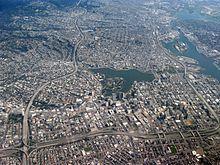
Oakland is on the east side of San Francisco Bay; in 1991 the City Hall tower was at 37 °48 a²19 a³N 122 °16 a²21 a³W / 37.805302 °N 122.272539 °W / 37.805302; -122.272539 (NAD83). (The building still exists, but like the rest of the Bay Area it has shifted northwest perhaps 0.6 meter in the last twenty years.)
The United States Census Bureau says the city's total area is 78.0 square miles (202 km2), including 55.8 square miles (145 km2) of land and 22.2 square miles (57 km2) (28.48 percent) of water.
Oakland's highest point is near Grizzly Peak Blvd, east of Berkeley, just over 1,760 feet (540 m) above sea level at about 37 °52 a²43 a³N 122 °13 a²27 a³W / 37.8786 °N 122.2241 °W / 37.8786; -122.2241. Oakland has 19 miles (31 km) of shoreline, but Radio Beach is the only beach in Oakland.
Oaklanders refer to their city's terrain as "the flatlands" and "the hills", which until recent waves of gentrification have also been a reference to Oakland's deep economic divide, with "the hills" being more affluent communities. About two-thirds of Oakland lies in the flat plain of the East Bay, with one-third rising into the foothills and hills of the East Bay range.
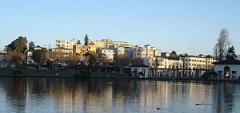
Oakland has more than 50 distinct neighborhoods. The greater divisions in the city include downtown Oakland and its greater Central Business District, Lake Merritt, East Oakland, North Oakland, West Oakland, and the Oakland Hills. East Oakland, which includes the East Oakland Hills, encompasses more than half of Oakland's land area, stretching from Lakeshore Avenue on the east shore of Lake Merritt southeast to the San Leandro border. North Oakland encompasses the neighborhoods between downtown and Berkeley and Emeryville. West Oakland is the area between downtown and the Bay, partially surrounded by the Oakland Point, and encompassing the Port of Oakland. In 2011, Oakland was ranked the 10th most walkable city in the United States.
Lake Merritt, an urban estuary near downtown, is a mix of fresh and salt water draining in and out from the Oakland Harbor at the San Francisco Bay and one of Oakland's most notable features. It was designated the United States' first official wildlife refuge in 1870. Originally a marsh-lined wildlife haven, Lake Merritt was dredged and bordered with parks from the 1890s to the 1910s. Despite this reduction in habitat, Oakland is home to a number of rare and endangered species, many of which are localized to serpentine soils and bedrock. Lake Merritt is surrounded by residential and business districts, including downtown and Grand Lake.
The city of Piedmont, incorporated in Oakland's central foothills after the 1906 earthquake, is a small independent city surrounded by the city of Oakland.
Based on data gathered by the National Oceanic and Atmospheric Administration, Oakland is ranked No. 1 in climate among U.S. cities. Oakland's climate is typified by the temperate and seasonal Mediterranean climate. Summers are usually dry and warm and winters are mild and wet. More specifically, it has features found in both nearby coastal cities such as San Francisco and inland cities such as San Jose, making it warmer than San Francisco and cooler than San Jose. Its position on San Francisco Bay across from the Golden Gate means that the Northern part of the city can experience cooling maritime fog. It is far enough inland, though, that the fog often burns off by midday, allowing it to have typically sunny California days. The hills tend to have more fog than the flatlands, as the fog drifts down from Berkeley.
The U.S. Weather Bureau kept weather records in downtown Oakland from October 4, 1894, to July 31, 1958. During that time, the record high temperature was 104 °F (40 °C) on June 24, 1957, and the record low temperature was 24 °F ( na4 °C) on January 23, 1949. The wettest year was 1940 with 38.65 inches (982 mm) and the driest year was 1910 with 12.02 inches (305 mm). The most rainfall in one month was 15.35 inches (390 mm) in January 1911. The most rainfall in 24 hours was 4.27 inches (108 mm) on February 12, 1904.
The National Weather Service today has two official weather stations in Oakland: Oakland International Airport and the Oakland Museum (established 1970).
Ruptures along the nearby San Andreas fault caused severe earth movement in the San Francisco Bay Area in 1906 and 1989. San Andreas quakes induces creep (movement occurring on earthquake faults) in the Hayward fault, which runs directly through Oakland, Berkeley, San Jose and other Bay Area cities. In 1991, an urban conflagration, the Oakland Hills Fire, destroyed nearly 4,000 homes and killed twenty five people in the Oakland hills range; it was the worst urban firestorm in American history.
The 2010 United States Census reported that Oakland had a population of 390,724. The population density was 5,009.2 people per square mile (1,934.0/km ²). The racial makeup of Oakland was 134,925 (34.5%) White, 109,471 (28.0%) African American, 3,040 (0.8%) Native American, 65,811 (16.8%) Asian (8.7% Chinese, 2.2% Vietnamese, 1.6% Filipino, 0.7% Cambodian, 0.7% Laotian, 0.6% Korean, 0.5% Japanese, 0.5% Indian), 2,222 (0.6%) Pacific Islander (0.3% Tongan), 53,378 (13.7%) from other races, and 21,877 (5.6%) from two or more races. Hispanic or Latino of any race were 99,068 persons (25.4%). Among the Hispanic population, 18.1% are Mexican, 1.9% Salvadoran, 1.3% Guatemalan, and 0.7% Puerto Rican.
The Census reported that 382,586 people (97.9% of the population) lived in households, 5,675 (1.5%) lived in non-institutionalized group quarters, and 2,463 (0.6%) were institutionalized.
There were 153,791 households, out of which 44,762 (29.1%) had children under the age of 18 living in them, 50,797 (33.0%) were opposite-sex married couples living together, 24,122 (15.7%) had a female householder with no husband present, 8,799 (5.7%) had a male householder with no wife present. There were 11,289 (7.3%) unmarried opposite-sex partnerships, and 3,442 (2.2%) same-sex married couples or partnerships. 52,103 households (33.9%) were made up of individuals and 13,778 (9.0%) had someone living alone who was 65 years of age or older. The average household size was 2.49. There were 83,718 families (54.4% of all households); the average family size was 3.27.
The population was spread out with 83,120 people (21.3%) under the age of 18, 36,272 people (9.3%) aged 18 to 24, 129,139 people (33.1%) aged 25 to 44, 98,634 people (25.2%) aged 45 to 64, and 43,559 people (11.1%) who were 65 years of age or older. The median age was 36.2 years. For every 100 females there were 94.2 males. For every 100 females age 18 and over, there were 91.8 males.
There were 169,710 housing units at an average density of 2,175.7 per square mile (840.0/km ²), of which 63,142 (41.1%) were owner-occupied, and 90,649 (58.9%) were occupied by renters. The homeowner vacancy rate was 3.0%; the rental vacancy rate was 8.5%. 166,662 people (42.7% of the population) lived in owner-occupied housing units and 215,924 people (55.3%) lived in rental housing units.
In 2008 the median income for a household in the city was $48,596 and the median income for a family was $55,949. Males had a median income of $46,383 versus $44,690 for females. The per capita income for the city was $30,094. In 2007 approximately 15.3 percent of families and 17.0 percent of the general population were below the poverty line, including 27.9 percent of those under age 18 and 13.1 percent of those age 65 or over. 0.7% of the population is homeless. Home ownership is 41% and 14% of rental units are subsidized. The unemployment rate as of August 2009 is 15.2%.
As of the census of 2000, the median income for a household in the city is $40,055, and the median income for a family is $44,384. Males have a median income of $37,433 versus $35,088 for females. The per capita income for the city is $21,936. 19.4% of the population and 16.2% of families are below the poverty line. Out of the total population, 27.9% of those under the age of 18 and 13.1% of those 65 and older are living below the poverty line.
Oakland is one of the most ethnically diverse major cities in the country. The city's formerly most populous ethnic group, white, declined from 95.3% in 1940 to 32.5% by 1990. Since the 1960s, Oakland has been known as a center of Northern California's African-American community. However, between 2000 and 2010 Oakland lost nearly 25% of its black population. The city demographics have changed due to a combination of gentrification, along with many blacks relocating to Bay Area suburbs, or moving to the Southern United States.[100][101][102] Blacks formed a strong plurality for many years, peaking in 1980 at about 47% of the population of Oakland. Despite the decline, black residents maintain their status as Oakland's single largest ethnic group as of 2010, at 27% of the population, followed by non-Hispanic whites at 26%, and Latinos of any race at 25%.[103]
Recent trends have resulted in cultural shifts, leading to a decline among some of the city's longstanding black institutions, such as churches, businesses, and nightclubs,[104] which has been a point of contention for some long-time black residents.
In recent years, immigrants and others have marched by the thousands down Oakland's International Boulevard in support of legal reforms benefiting illegal immigrants.[105]
An analysis by the Urban Institute of U.S. Census 2000 numbers showed that Oakland had the third-highest concentration of gays and lesbians among the 50 largest U.S. cities, behind San Francisco and Seattle. Census data showed that, among incorporated places that have at least 500 female couples, Oakland had the nation's largest proportion. In 2000, Oakland counted 2,650 lesbian couples; one in every 41 Oakland couples listed themselves as a same-sex female partnership.[106][107]
In 2010, violent crime in general was down 27% and the homicide drop was the city's fourth in a row. Both violent crime in general, and homicides in particular, increased during 2011.[108] The Oakland police department is committed to improved public safety by increasing police presence during peak crime hours, improving intelligence gathering, and prioritizing the arrest of violent crime suspects.[109][110]
Oakland's crime rate began to escalate during the late 1960s, and by the end of the 1970s Oakland's per capita murder rate had risen to twice that of its neighbor city, San Francisco or New York City.[111] During the first decade of the 21st century Oakland has consistently been listed as one of the most dangerous large cities in the United States.[112] Among Oakland's 35 police patrol beats, violent crime remains a serious problem in specific East and West Oakland neighborhoods. In 2008, homicides were disproportionately concentrated: 72% occurred in three City Council districts, District 3 in West Oakland and Districts 6 and 7 in East Oakland, even though these districts represent only 44% of Oakland's residents.[113]
Oakland is a major West Coast port, and the fifth busiest in the United States by cargo volume.[114] There are nearly 200,000 jobs related to marine cargo transport in the Oakland area.[115] These jobs range from minimum wage hourly positions to Transportation Storage and Distribution Managers who earn an annual average salary of $91,520.[116] The Port of Oakland was an early innovator/pioneer in the technologies of Intermodal Containerized Shipping. The city is also home to several major corporations including Matson, Kaiser Permanente and Clorox, as well as corporate headquarters for national retailers like Dreyer's and Cost Plus World Markets.[117] The first Longs Drugs store opened in Oakland. Tech companies such as Ask.com and Pandora Radio are located in Oakland,[118] and in recent years many start-up high tech and green energy companies have found a home in the downtown neighborhoods of Uptown, City Center, Jack London Square and Lake Merritt Financial District.[119]
Oakland experienced an increase of both its population and of land values in the early-to-mid first decade of the 21st century. The 10k Plan, which began during former mayor Elihu Harris' administration, and intensified during former mayor Jerry Brown's administration resulted in several thousand units of new multi-family housing and development.
According to the City's 2010 Comprehensive Annual Financial Report,[120] the top employers in the city are:
Oakland has a significant art scene and claims the highest concentration of artists per capita in the United States.[121] Galleries exist in various parts of Oakland, with the newest additions centered mostly in the Uptown area. The city offers a wide variety of cuisine in both restaurants and markets, often featuring locally grown produce and international foods which reflect the city aos ethnically diverse population. Historically a focal point of the West Coast blues and jazz scenes, Oakland is also home to musicians representing such genres as rhythm and blues, funk, punk, heavy metal, Rap/Gangsta rap, and hip hop.
Events which celebrate the diverse cultures of Oakland include:
Downtown Oakland has an assortment of bars and nightclubs. They include dive bars, dance clubs, modern lounges and jazz bars. The Paramount Theater features headlining musical tours and productions, while Fox Oakland Theatre draws various musical genres including jam bands, rock, punk, blues, jazz, and reggae. The Paramount and Fox theaters often book simultaneous events creating busy nights uptown.[122]

Oakland was written about by Gertrude Stein in her 1937 book Everybody's Autobiography: "There is no there there." Originally declared upon learning as an adult her childhood home in Oakland had been torn down, over time the quote has become misconstrued to represent the city of Oakland itself.[124][125]
Modern-day Oakland has turned the quote on its head, with a statue downtown simply titled "There." Additionally, in 2005 a sculpture called HERETHERE was installed by the City of Berkeley on the Berkeley-Oakland border at Martin Luther King Jr. Way. The sculpture consists of eight-foot-tall letters spelling "HERE" and "THERE" in front of the BART tracks as they descend from their elevated section in Oakland to the subway through Berkeley.[126]
Oakland has teams in three professional sports: Basketball, baseball, and football.
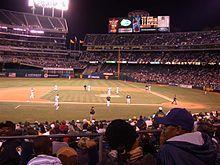
Oakland's former sports teams include:
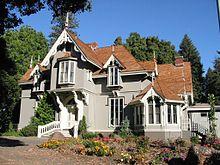
Oakland has many parks including:
Additionally, the following seven East Bay Regional Parks are located entirely or partially in the city of Oakland:
Some of the most prominent places of worship in Oakland include: First Congregational Church of Oakland, Evangelistic Outreach Center, Green Pastures, the Presbyterian, First Presbyterian Church of Oakland; Greek Orthodox Ascension Cathedral; the Roman Catholic Cathedral of Christ the Light; the United Methodist Chinese Community Church; the Unitarian First Unitarian Church; the Mormon Oakland California Temple; the Muslim, 31st Street Islamic Center, Light-House Mosque; the Reform Jewish Temple Sinai; the Conservative Jewish, Temple Beth Abraham; and the Orthodox Jewish, Beth Jacob Congregation, American Baptist; Faith Baptist Church of Oakland and the Kingdom Hall of Jehovah's Witnesses.
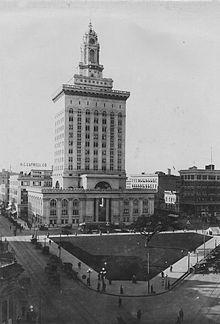
Oakland has a mayor-council government. The mayor is elected for a four-year term. The Oakland City Council has eight council members representing seven districts in Oakland with one member elected at-large; council members serve staggered four-year terms. The mayor appoints a city administrator, subject to the confirmation by the City Council, who is the chief administrative officer of the city. Other city officers include: city attorney (elected), city auditor (elected), and city clerk (appointed by city administrator).[128] Oakland's Mayor is subject to a tenure limited to two terms. There are no term limits for the city council. Three council members are currently on their fourth term, and Councilman De La Fuente is serving for his fifth term, approaching two decades in office.
Oakland City Hall was evacuated after the 1989 Loma Prieta earthquake until $80M seismic retrofit and hazard abatement work was complete in 1995.[129]
Jean Quan was elected mayor in November 2010, beating Don Perata and Rebecca Kaplan in the city's first ranked choice balloting.[130]
In the state legislature Oakland is located in the 9th Senate District, represented by Democrat Loni Hancock, and in the 14th, 16th, and 18th Assembly Districts, represented by Democrats Nancy Skinner, Sandre Swanson, and Mary Hayashi respectively. Oakland is represented in the United States House of Representatives by Barbara Lee and is located in California's 9th Congressional District, which has a Cook PVI of D +38.[131]
Most public schools in Oakland are operated by the Oakland Unified School District (OUSD), which covers the entire city of Oakland; due to financial troubles and administrative failures, it has been in receivership by the state of California since 2002. The Oakland Unified School District (2006 ae2007) includes 59 elementary schools, 23 middle schools, 19 high schools, with 9 alternative education schools and programs, 4 adult education schools and early childhood education centers at most of the elementary schools[132] There are 46,000 K ae12 students, 32,000 adult students, and 6,000 plus employees.[133] Overall, OUSD schools have performed poorly for years. In the 2005 results of the STAR testing, over 50 percent of students taking the test performed "below basic," while only 20 percent performed at least "proficient" on the English section of the test.[134] Some individual schools have much better performance than the city-wide average, for instance, in 2005 over half the students at Hillcrest Elementary School in the Montclair upper hills neighborhood performed at the "advanced" level in the English portion of the test, and students at Lincoln Elementary School in the Chinatown neighborhood performed at the "advanced" level in the math portion.
Oakland's three largest public high schools are Oakland High School, Oakland Technical High School, and Skyline High School. Oakland Tech has various academies, including its much renowned Engineering Academy, which sent more girls to MIT in 2007 than any other public school west of the Mississippi. There are also numerous small public high schools within Castlemont Community of Small Schools, Fremont Federation of High Schools, and McClymonds Educational Complex, all of which were once single, larger public high schools that were reorganized due to poor performance (Castlemont High School, Fremont High School, and McClymonds High School, respectively).
25 public charter schools with 5,887 students[135] operate outside the domain of OUSD. One, North Oakland Community Charter School (NOCCS), an elementary and middle school, is one of the few public progressive schools in the country. Lionel Wilson College Prep Academy and Oakland Unity High School have been certified by the California Charter Schools Association.[136][137] Other charter schools include the Oakland Military Institute, Oakland School for the Arts, Bay Area Technology School, and Oakland Charter Academy.[138]
There are several private high schools. Notables include the secular The College Preparatory School and Head-Royce School, and the Catholic Bishop O'Dowd High School, Holy Names High School and St. Elizabeth High School. Catholic schools in Oakland are operated by the Roman Catholic Diocese of Oakland also include 8 K ae8 schools (plus 1 in Piedmont on the Oakland city border). Northern Light School is a private nonprofit elementary and middle school. Bentley School is an Independent Co-educational K ae12, college preparatory school, located on two campuses in Oakland and Lafayette, California.
Accredited colleges and universities include:
In 2001, the SFSU Oakland Multimedia Center was opened, allowing San Francisco State University to conduct classes near downtown Oakland.[139] The Oakland Higher Education Consortium and the City of Oakland's Community and Economic Development Agency (CEDA) opened the Oakland Higher Education Center downtown in 2002 to provide "access to multiple higher education service providers within a shared urban facility." Member schools include primary user California State University, East Bay as well as Lincoln University, New College of California, Saint Mary's College of California, SFSU Multimedia Studies Program, UC Berkeley Extension, University of Phoenix and Peralta Community College District.[140][141]
Oakland is served by major television stations broadcasting primarily out of San Francisco and San Jose. The region's Fox affiliate, KTVU, is based in (and licensed to) Oakland at Jack London Square along with co-owned independent station KICU-TV (licensed to San Jose). In addition, the city is served by various AM and FM radio stations as well; AM stations KKSF, KMKY, KNEW and KQKE are licensed to Oakland.
Oakland is served by the Oakland Tribune which published its first newspaper on February 21, 1874. The Tribune Tower, which sports a clock, is one of Oakland's landmarks. At key times throughout the day (8:00 am, noon and 5:00 pm), the clock tower carillon plays a variety of classic melodies, which change on a daily basis. In 2007, the Oakland Tribune moved its offices from the tower to an East Oakland location, before folding in 2011.[142]
The East Bay Express, a locally-owned free weekly paper, is based in Jack London Square and distributed throughout the East Bay.
Oakland news blogs and hyperlocal news sites include Oakland Focus, Oakland Local, Living in the O, Back to Oakland, Ella's Voice, Fragmentary Evidence, Oakland North, OakTalk, Oaktown Art, Our Oakland, The DTO (Downtown Oakland), The OakBook, and Walk Oakland Bike Oakland.
Oakland residents have access to the three major airports of the San Francisco Bay Area: Oakland International Airport, San Francisco International Airport, and San Jose International Airport. Oakland International Airport, located within the city limits of Oakland, is 4 miles (6 km) south of downtown Oakland and serves domestic and international destinations. AC Transit provides 24-hour service to the airport, and the AirBART shuttle provides frequent service between the airport and BART's Oakland Coliseum Station.
The city has regional and long distance passenger train service provided by Amtrak, with stations located near Jack London Square and the Oakland Coliseum. Amtrak's California Zephyr has its western terminus at the nearby Emeryville, CA station.
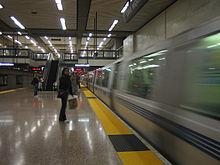
The most recent census data compiled in 2007 before gasoline price spikes in 2008, show 24.3 percent of Oaklanders used public transportation, walked or used "other means" to commute to work, not including telecommuting,[143] with 17 percent of Oakland households being "car free" and or statistically categorized as having "no vehicles available."[144]
Bus transit service in Oakland and the inner East Bay is provided by the Alameda and Contra Costa Transit District, AC Transit. The district originated in 1958 after the conspiratorial dissolution of the Key System of streetcars. Many AC Transit lines follow old routes of the Key System.
The metropolitan area is served by Bay Area Rapid Transit (BART) from eight stations in Oakland. The system has headquarters in Oakland, with major transfer hubs at MacArthur and 19th Street stations. BART's headquarters was located in a building above the Lake Merritt BART station until 2006, when it relocated to the Kaiser Center due to seismic safety concerns.
The Alameda / Oakland Ferry operates ferry service from Jack London Square to Alameda, San Francisco, and Angel Island. Oakland licenses taxi cabs, and has zoned cab stands in its downtown, including a bicycle pedi-cab service.
The Oakland City Council adopted a Bicycle Master Plan in 1999 as a part of the Land Use and Transportation (LUTE) element of Oakland's 1998 General Plan. In addition, the Oakland City Council reaffirmed the bike plan in 2005 and 2007. Several miles of bike lanes were created as a result of the plan, with more awaiting funding. Facilities for parking thousands of bicycles have been installed downtown and in other commercial districts throughout Oakland.
Oakland is served by several major highways: Eastbound Bay Bridge traffic entering Oakland then splits into three freeways at the MacArthur Maze freeway interchange: Interstate 580 (MacArthur Freeway) heads southeast toward Hayward and eventually to the California Central Valley; Interstate 880 (Nimitz Freeway) runs south to San Jose; and the Eastshore Freeway (Interstate 80/I-580) runs north, providing connections to Sacramento and San Rafael, respectively. Interstate 980 (Williams Freeway) begins its eastbound journey at I-880 in Downtown Oakland before turning into State Route 24 (Grove Shafter Freeway) at I-580. State Route 13 begins as the Warren Freeway at I-580, and runs through a scenic valley in the Montclair District before entering Berkeley. A stub of a planned freeway was constructed at the High Street exit from the Nimitz Freeway, but that freeway extension plan was abandoned.
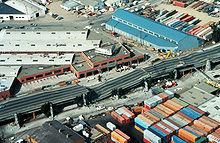
In 1989, the Loma Prieta earthquake caused the Cypress Street Viaduct double-deck segment of the Nimitz Freeway to collapse, killing 42 people. The old freeway segment had passed through the middle of West Oakland, forming a barrier between West Oakland neighborhoods. Following the earthquake, this section was rerouted around the perimeter of West Oakland and rebuilt in 1999. The east span of the San Francisco ae Oakland Bay Bridge also suffered damage from the quake when a 50-foot (15 m) section of the upper deck collapsed onto the lower deck; the damaged section was repaired within a month of the earthquake. As a result of Loma Prieta, a significant seismic retrofit was performed on the western span of the Bay Bridge. The eastern span is currently being replaced, with a projected completion date of 2014.
Two underwater tunnels, the Webster and Posey Tubes, connect the main island of Alameda to downtown Oakland, coming above ground in Chinatown. In addition, the Park Street, Fruitvale, and High Street bridges connect Alameda to East Oakland over the Oakland Estuary.
In the hills, the Leimert Bridge crosses Dimond Canyon, connecting the Oakmore neighborhood to Park Boulevard. The Caldecott Tunnel carries Highway 24 through the Berkeley Hills, connecting central Contra Costa County to Oakland. The Caldecott has three bores, with a fourth under construction.
Freight service, which consists primarily of moving shipping containers to and from the Port of Oakland, is provided today by Union Pacific Railroad (UP), and to a lesser extent by BNSF Railway (which now shares the tracks of the UP between Richmond and Oakland).
Historically, Oakland was served by several railroads. Besides the transcontinental line of the Southern Pacific, there was also the Santa Fe (whose Oakland terminal was actually in Emeryville), the Western Pacific Railroad (who built a pier adjacent to the SP's), and the Sacramento Northern Railroad (eventually absorbed by the Western Pacific, which in turn was absorbed by UP in 1983).
As one of the three major ports on the West Coast of the United States, the Port of Oakland is the largest seaport on San Francisco Bay and the fifth busiest container port in the United States. It was one of the earliest seaports to switch to containerization and to intermodal container transfer,[145] thereby displacing the Port of San Francisco, which never modernized its waterfront. One of the earlier limitations to growth was the inability to transfer containers to rail lines, all cranes historically operating between ocean vessels and trucks. In the 1980s the Port of Oakland began the evaluation of development of an intermodal container transfer capability, i.e. facilities that now allow trans-loading of containers from vessels to either trucks or rail modes.
Water and sewage treatment are provided by East Bay Municipal Utility District (EBMUD). Pacific Gas and Electric Company provides natural gas and electricity service. Municipal garbage collection is franchised to Waste Management, Inc. Telecommunications and subscriber television services are provided by multiple private corporations and other service providers in accordance with the competitive objectives of the Telecommunications Act of 1996.
Oakland tops the list of the 50 largest US cities using electricity from renewable sources.[146]
Originating in Oakland, Kaiser Permanente, is an HMO started in 1942, during World War II, by industrialist Henry J. Kaiser to provide medical care for Kaiser Shipyards workers. It is the largest managed care organization in the United States and the largest non-governmental health care provider in the world.[147] It is headquartered at 1950 Franklin Street in Downtown Oakland and maintains a large medical center in the Piedmont Avenue neighborhood.
Alta Bates Summit Medical Center, an East Bay hospital system, maintains its Summit Campus in the neighborhood known as "Pill Hill" north of downtown. Until 2000, it was the Summit Medical Center before merging with Berkeley-based Alta Bates. All campuses now operate under the Sutter Health network.
Alameda County Medical Center is operated by the county and provides medical services to county residents, including the medically indigent who do not have health insurance. The main campus, Highland Hospital in East Oakland, is the trauma center for the northern area of the East Bay.
Children's Hospital Oakland is the primary medical center specializing in pediatrics in the East Bay. It is a designated Level I pediatric trauma center, and the only independent children's hospital in Northern California.
Oakland has nine sister cities:[148]


Word Count: 10185







